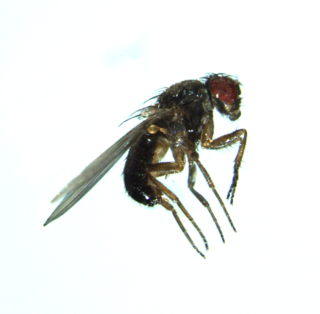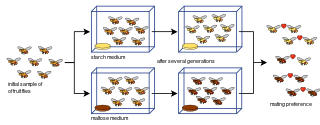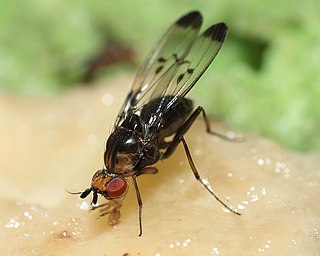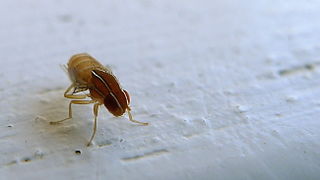Related Research Articles

Drosophila is a genus of flies, belonging to the family Drosophilidae, whose members are often called "small fruit flies" or pomace flies, vinegar flies, or wine flies, a reference to the characteristic of many species to linger around overripe or rotting fruit. They should not be confused with the Tephritidae, a related family, which are also called fruit flies ; tephritids feed primarily on unripe or ripe fruit, with many species being regarded as destructive agricultural pests, especially the Mediterranean fruit fly.

Drosophila melanogaster is a species of fly in the family Drosophilidae. The species is often referred to as the fruit fly, though its common name is more accurately the vinegar fly. Starting with Charles W. Woodworth's proposal of the use of this species as a model organism, D. melanogaster continues to be widely used for biological research in genetics, physiology, microbial pathogenesis, and life history evolution. As of 2017, six Nobel Prizes have been awarded for research using Drosophila.

Allopatric speciation, also referred to as geographic speciation, vicariant speciation, or its earlier name, the dumbbell model, is a mode of speciation that occurs when biological populations become geographically isolated from each other to an extent that prevents or interferes with gene flow.

Peripatric speciation is a mode of speciation in which a new species is formed from an isolated peripheral population. Since peripatric speciation resembles allopatric speciation, in that populations are isolated and prevented from exchanging genes, it can often be difficult to distinguish between them. Nevertheless, the primary characteristic of peripatric speciation proposes that one of the populations is much smaller than the other. The terms peripatric and peripatry are often used in biogeography, referring to organisms whose ranges are closely adjacent but do not overlap, being separated where these organisms do not occur—for example on an oceanic island compared to the mainland. Such organisms are usually closely related ; their distribution being the result of peripatric speciation.

Drosophila simulans is a species of fly closely related to D. melanogaster, belonging to the same melanogaster species subgroup. Its closest relatives are D. mauritiana and D. sechellia.
Meiotic drive is a type of intragenomic conflict, whereby one or more loci within a genome will effect a manipulation of the meiotic process in such a way as to favor the transmission of one or more alleles over another, regardless of its phenotypic expression. More simply, meiotic drive is when one copy of a gene is passed on to offspring more than the expected 50% of the time. According to Buckler et al., "Meiotic drive is the subversion of meiosis so that particular genes are preferentially transmitted to the progeny. Meiotic drive generally causes the preferential segregation of small regions of the genome".
The mechanisms of reproductive isolation are a collection of evolutionary mechanisms, behaviors and physiological processes critical for speciation. They prevent members of different species from producing offspring, or ensure that any offspring are sterile. These barriers maintain the integrity of a species by reducing gene flow between related species.
The fruitless gene (fru) is a Drosophila melanogaster gene that encodes several variants of a putative transcription factor protein. Normal fruitless function is required for proper development of several anatomical structures necessary for courtship, including motor neurons which innervate muscles needed for fly sexual behaviors. The gene does not have an obvious mammalian homolog, but appears to function in sex determination in species as distant as the mosquito Anopheles gambiae.
The concept of a biological species as a group of organisms capable of interbreeding to produce viable offspring dates back to at least the 18th century, although it is often associated today with Ernst Mayr. Species of the fruit-fly Drosophila are one of the most commonly used organisms in evolutionary research, and have been used to test many theories related to the evolution of species. The genus Drosophila comprises numerous species that have varying degrees of premating and postmating isolation between them. These species are useful for testing hypotheses of the reproductive mechanisms underlying speciation.

Drosophila pseudoobscura is a species of fruit fly, used extensively in lab studies of speciation. It is native to western North America.
A behaviour mutation is a genetic mutation that alters genes that control the way in which an organism behaves, causing their behavioural patterns to change.

Drosophila subobscura is a species of fruit fly in the family Drosophilidae. Originally found around the Mediterranean, it has spread to most of Europe and the Near East. It has been introduced into the west coasts of Canada, the United States, and Chile. Its closest relative is Drosophila madeirensis, found in the Madeira Islands, followed by D. guanche, found in the Canary Islands. These three species form the D. subobscura species subgroup. When they mate, males and females perform an elaborate courtship dance, in which the female can either turn away to end the mating ritual, or stick out her proboscis in response to the male's, allowing copulation to proceed. D. subobscura has been regarded as a model organism for its use in evolutionary-biological studies.
Drosophila mauritiana is a species of fly, belonging to the family Drosophilidae. It belongs to the Drosophila melanogaster species subgroup. It is found in Mauritius.
The Drosophila elegans species subgroup contains 3 species. The subgroup belongs to the Drosophila melanogaster species group within the subgenus Sophophora.

Reinforcement is a process of speciation where natural selection increases the reproductive isolation between two populations of species. This occurs as a result of selection acting against the production of hybrid individuals of low fitness. The idea was originally developed by Alfred Russel Wallace and is sometimes referred to as the Wallace effect. The modern concept of reinforcement originates from Theodosius Dobzhansky. He envisioned a species separated allopatrically, where during secondary contact the two populations mate, producing hybrids with lower fitness. Natural selection results from the hybrid's inability to produce viable offspring; thus members of one species who do not mate with members of the other have greater reproductive success. This favors the evolution of greater prezygotic isolation. Reinforcement is one of the few cases in which selection can favor an increase in prezygotic isolation, influencing the process of speciation directly. This aspect has been particularly appealing among evolutionary biologists.

Reinforcement is a process within speciation where natural selection increases the reproductive isolation between two populations of species by reducing the production of hybrids. Evidence for speciation by reinforcement has been gathered since the 1990s, and along with data from comparative studies and laboratory experiments, has overcome many of the objections to the theory. Differences in behavior or biology that inhibit formation of hybrid zygotes are termed prezygotic isolation. Reinforcement can be shown to be occurring by measuring the strength of prezygotic isolation in a sympatric population in comparison to an allopatric population of the same species. Comparative studies of this allow for determining large-scale patterns in nature across various taxa. Mating patterns in hybrid zones can also be used to detect reinforcement. Reproductive character displacement is seen as a result of reinforcement, so many of the cases in nature express this pattern in sympatry. Reinforcement's prevalence is unknown, but the patterns of reproductive character displacement are found across numerous taxa, and is considered to be a common occurrence in nature. Studies of reinforcement in nature often prove difficult, as alternative explanations for the detected patterns can be asserted. Nevertheless, empirical evidence exists for reinforcement occurring across various taxa and its role in precipitating speciation is conclusive.

Laboratory experiments of speciation have been conducted for all four modes of speciation: allopatric, peripatric, parapatric, and sympatric; and various other processes involving speciation: hybridization, reinforcement, founder effects, among others. Most of the experiments have been done on flies, in particular Drosophila fruit flies. However, more recent studies have tested yeasts, fungi, and even viruses.

Drosophila silvestris is a large species of fly in the family Drosophilidae that are primarily black with yellow spots. As a rare species of fruit fly endemic to Hawaii, the fly often experiences reproductive isolation. Despite barriers in nature, D. silvestris is able to breed with D. heteroneura to create hybrid flies in the laboratory.

Zaprionus tuberculatus is a member of the subgenus and genus Zaprionus, family Drosophilidae, and order Diptera. It is an invasive fruit fly that originated in Africa, but can also be found in Europe and Asia. The fly earned its common name, the "vinegar fly", because researchers frequently captured the species using vinegar traps. Z. tuberculatus was previously considered a strictly tropical fly, but evidence of invasion to nontropical regions such as Turkey has been shown.
Abdominal pigmentation in Drosophila melanogaster is a morphologically simple but highly variable trait that often has adaptive significance. Pigmentation has extensively been studied in Drosophila melanogaster. It has been used as a model for understanding the development and evolution of morphological phenotypes.
References
- ↑ Jallon, Jean-Marc; David, Jean R. (March 1987). "Variations in Cuticular Hydrocarbons Among the Eight Species of the Drosophila Melanogaster Subgroup". Evolution; International Journal of Organic Evolution. 41 (2): 294–302. doi: 10.1111/j.1558-5646.1987.tb05798.x . ISSN 1558-5646. PMID 28568760. S2CID 39388875.
- ↑ Ewing, Arthur W.; Bennet-Clark, H. C. (1968). "The Courtship Songs of Drosophila". Behaviour. 31 (3/4): 288–301. doi:10.1163/156853968X00298. JSTOR 4533231.
- ↑ ZHANG, LI; KANG, HAN; JIN, SHAN; ZENG, QING TAO; YANG, YONG (2016-05-16). "Hsp27 gene in Drosophila ananassae subgroup was split by a recently acquired intron". Journal of Genetics. 95 (2): 257–262. doi:10.1007/s12041-016-0629-y. ISSN 0022-1333. PMID 27350667. S2CID 15397411.
- ↑ Simão, M C; Haudry, A; Granzotto, A; Setta, N; Carareto, C M A (2018-08-25). "Helena and BS: two travellers between the genera Drosophila and Zaprionus". Genome Biology and Evolution. 10 (10): 2671–2685. doi:10.1093/gbe/evy184. ISSN 1759-6653. PMC 6179348 . PMID 30165545.
- J. A. Coyne, S. Elwyn, S. Y. Kim & A. Llopart 2004. Genetic studies of two sister species in the Drosophila melanogaster subgroup, D. yakuba and D. santomea. Genetical Research 84: 11-26.
- R. M. Kliman, P. Andolfatto, J. A. Coyne, F. Depaulis, M. Kreitman, A. J. Berry, J. McCarter, J. Wakeley & J. Hey 2000. The population genetics of the origin and divergence of the Drosophila simulans complex species. Genetics 156: 1913-1931.